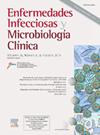加泰罗尼亚地区卫生保健相关尿路感染的患病率
IF 2.6
4区 医学
Q3 INFECTIOUS DISEASES
Enfermedades infecciosas y microbiologia clinica
Pub Date : 2025-01-13
DOI:10.1016/j.eimc.2024.06.011
引用次数: 0
摘要
医疗保健相关尿路感染(hca - uti)在急性护理医院(ACH)和长期护理机构(LTCF)的感染中占重要比例。我们的目的是评估加泰罗尼亚地区hca - uti的患病率。方法描述性观察性研究分析了hca - uti的患病率,包括导管相关uti (CAUTIs)和非CAUTIs,从2013年至2022年期间进行的55例ACH(44,734例患者)和97例LTCF(116,882名居民)的点状患病率调查中,作为VINCat项目的一部分。流行时间趋势也通过Spearman相关性进行评估。结果在ACH中,HCA-UTI的总患病率为1.6%。CAUTI患病率为3.9%,非CAUTI患病率为1%,随时间变化无显著性变化。重症监护室感染在大型医院和专科医院更为普遍。695例hca - uti中,CAUTIs 325例(46.8%),非CAUTIs 370例(53.2%)。LTCF中HCA-UTI的总体患病率为3.6%。CAUTI和非CAUTI的患病率分别为11%和2.8%,随时间无显著变化。在4190例hca - uti中,1200例(28.6%)为CAUTIs, 2990例(71.4%)为非CAUTIs。结论在ACH和LTCF中,大多数hca - uti为非cautis,尽管有导尿管的患者发生hca - uti的风险更高。hca - uti监测规划对于识别高危患者和制定预防策略至关重要。本文章由计算机程序翻译,如有差异,请以英文原文为准。
Prevalence of healthcare-associated urinary tract infections in Catalonia
Introduction
Healthcare-associated urinary tract infections (HCA-UTIs) account for an important number of infections in acute care hospitals (ACH) and long-term care facilities (LTCF). Our objective was to evaluate the prevalence of HCA-UTIs in Catalonia.
Methods
Descriptive observational study in which we analyzed the prevalence of HCA-UTIs, including catheter-associated UTIs (CAUTIs) and non-CAUTIs, from point prevalence surveys conducted in 55 ACH (44,734 patients) and 97 LTCF (116,882 residents) between 2013 and 2022 as part of the VINCat program. Prevalence time trends were also assessed by using a Spearman correlation.
Results
In ACH, the overall prevalence of HCA-UTI was 1.6%. The prevalence of CAUTI was 3.9%, while the prevalence of non-CAUTI was 1%, with no significant changes over time. CAUTIs were more prevalent in large size and specialty hospitals. Among the 695 HCA-UTIs, 325 (46.8%) were CAUTIs and 370 (53.2%) non-CAUTIs. The overall prevalence of HCA-UTI in LTCF was 3.6%. The prevalence of CAUTI and non-CAUTI was 11% and 2.8%, respectively, with no significant changes over time. Among the 4190 HCA-UTIs, 1200 (28.6%) were CAUTIs and 2990 (71.4%) non-CAUTIs.
Conclusion
Most HCA-UTIs, in ACH and LTCF, were non-CAUTIs although patients with a urinary catheter had a higher risk of HCA-UTIs. HCA-UTIs surveillance programs are essential for identifying at risk patients and developing preventive strategies.
求助全文
通过发布文献求助,成功后即可免费获取论文全文。
去求助
来源期刊
CiteScore
2.10
自引率
8.00%
发文量
194
审稿时长
29 days
期刊介绍:
Hoy está universalmente reconocida la renovada y creciente importancia de la patología infecciosa: aparición de nuevos agentes patógenos, de cepas resistentes, de procesos con expresión clínica hasta ahora desconocida, de cuadros de una gran complejidad. Paralelamente, la Microbiología y la Infectología Clínicas han experimentado un gran desarrollo como respuesta al reto planteado por la actual patología infecciosa. Enfermedades Infecciosas y Microbiología Clínica es la Publicación Oficial de la Sociedad Española SEIMC. Cumple con la garantía científica de esta Sociedad, la doble función de difundir trabajos de investigación, tanto clínicos como microbiológicos, referidos a la patología infecciosa, y contribuye a la formación continuada de los interesados en aquella patología mediante artículos orientados a ese fin y elaborados por autores de la mayor calificación invitados por la revista.

 求助内容:
求助内容: 应助结果提醒方式:
应助结果提醒方式:


